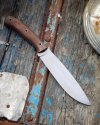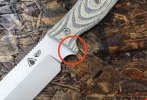Thank you for the kind words John. I am pleased to hear that my post was a worthwhile read for you.
The opinions I stated above were drawn from the experience of owning, using, and comparing a couple hundred fixed blades over the last dozen years. It was only about six years ago that I got serious about applying some critical analysis to understanding why one knife works for me and another doesn’t. Those comparison and analysis exercises came in handy in the last three years after I hit the accumulation wall on my collection and started making hard choices about what to let go of and why on the road to a much smaller group of favorite users. The slow refining process yielded yet more clarity and a strong sense of contentment in what remains even though the number is less than 20% of where I started.
I think you are on the right track with the design parameters you penciled out for the next project. The only feature that gives me some “wait and see” pause is the bird beak pommel. That is a classic design feature that can make or break my interest in a given knife. I like look and feel of a proportionate short/small beak on small-to-medium size knives. Large choppers can justify a bigger beak because it serves a purpose in added grip security when swinging the blade.
My rule of thumb on medium and smaller knives is that if my eye is easily drawn to the bird beak as a prominent feature on the handle, that means it is too big. That problem becomes even worse if it is combined with a significant forward rake in the primary pommel angle. I don’t a long handle that performs like a short handle just because the maker is going for a certain cool look.
About five years ago I posted an answer to a question in the Fiddleback sub-forum that relates to this topic. The OP asked why his new Bushcrafter Jr. felt 1/4” shorter than his Patch even though the BC Jr. has a longer handle. I had examples of both knives on hand that I photographed to explain my answer.
The Bushcrafter Jr. has what I consider a relatively small bird beak. Even so, the inward curve of the beak intrudes on the length of the bottom edge of the handle. In this photo, #1 is the point of the bird beak and #2 points to the depression where the center of your index feature most naturally sits. The distance between the two arrows is an indicator of useable handle length.
Without moving the numbered stickies at all, I photographed the Patch with #2 lined-up with the center of the index finger depression. The #1 label points 1/4” points ahead of the back edge on the bottom of the handle. That explained why the OP noticed the Patch handle felt bigger.
The following comparison photo shows that the Patch has a shallower “m” curve on the bottom of the handle than the BC Jr., which contributes to a more open and maneuverable feel in hand.
I don’t expect everyone to share or agree with my preferences on handle design. I enjoy hearing other experienced opinions because the learning never stops with this hobby.
My last word is that I am very much looking forward to the Cowbell Pocket Blade when my turn on the Dibs list comes up. That knife ticks all of the features I like and none that don’t. Keep doing what you are doing John! You nailed it.
Phil










